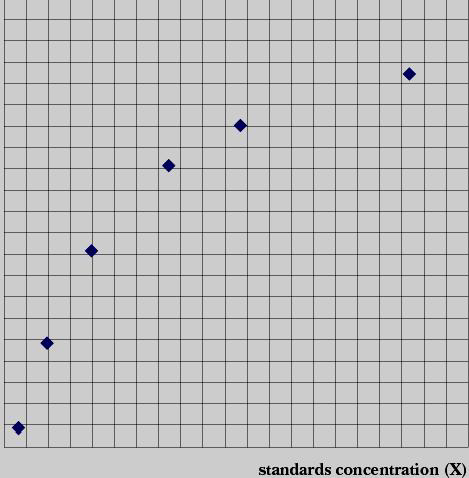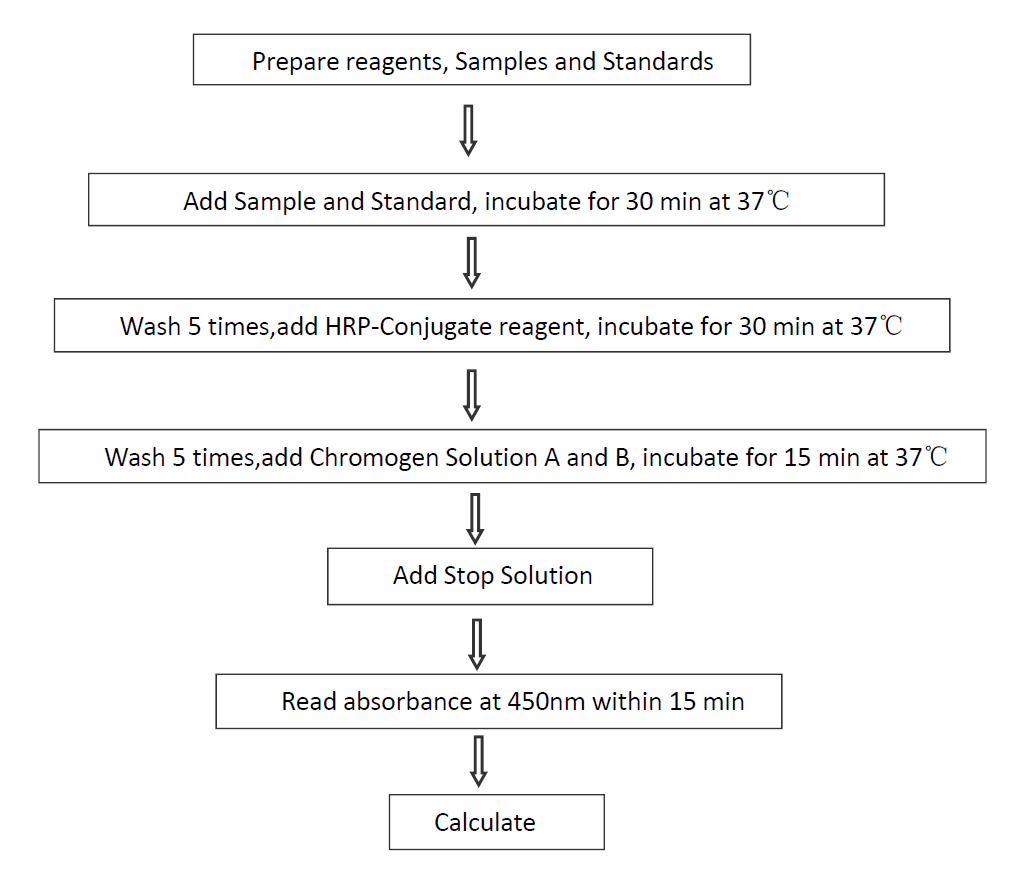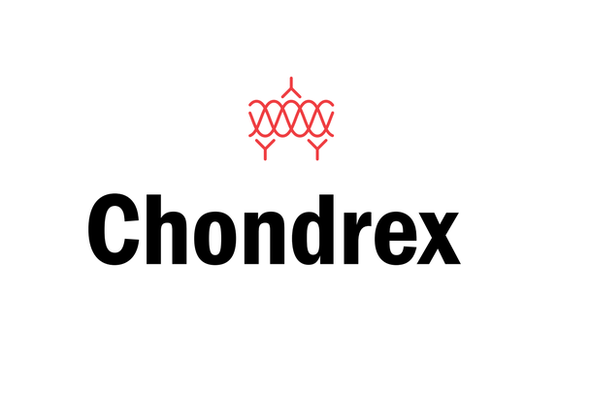Description
The Chicken Total Collagen (T COL) ELISA Kit is to be used for the vitro quantitative determination of Chicken T COL in Serum, Plasma, Tissue and other biological fluids. The Kit is intended for research use only, not for diagnostic or therapeutic procedure. If detection of other special sample, please contact our technical support.
Chicken Total Collagen (T COL) ELISA Kit DataSheet
2. PRINCIPLE OF THE ASSAY
The kit assay Chicken T COL level in the Samples, use Purified Chicken T COL antibody to coat microtiter plate wells, make solid-phase antibody, then add Samples (Containing Chicken T COL) to wells, combined Chicken T COL antidody which with HRP labeled, become antibody - antigen - enzyme-antibody complex, after washing completely, add TMB substrate solution, TMB substrate becomes blue color at HRP enzyme-catalyzed, reaction is terminated by the addition of a sulphuric acid solution and the color change (yellow) is measured spectrophotometrically at a wavelength of 450 nm. The concentration of Chicken T COL in the samples is then determined by comparing the O.D. of the samples to the standard curve.

3. KIT COMPONENTS AND STORAGE INSTRUCTIONS

Hints:
- All the components in the kit should be stored up to 10 months at 2-8℃,and should be kept according to the labels on vials. (Storage:2-8 ℃ Validity: 10 months)
- The kit takes out from the refrigeration environment should be balanced 15-30 minutes in the room temperature then use.
- The kit contain sufficient materials to run ELISAs on 96 or 48 microplates. Specific vial volume of each component may vary.Please check carefully if all components is in the correct volume. Gentaur has no any responsibility for the Check negligence.
- Washing Buffer will present Crystallization separation, and it can be heated in the water helping to dissolve,which does not affect the result.
- Closure plate membrane only limits the disposable use, in order to avoid the overlapping pollution
- Add sample within 5 min.
- Please keeping the TMB Substrate evade the light preservation.
- Upon receipt, foil pouch around the plate should be vacuum-sealed.
- Please avoid repeated freeze-thaw cycles and do not mix reagents from different kits unless they have the same lot numbers.
- After use remaining reagents should be returned to cold storage (2° to 8°C) immediately. Besides, please return the unused wells to the foil pouch containing the desiccant pack, and reseal along entire edge of zip-seal.
- Do not use components beyond the expiration date.Expiry of the kit components can only be guaranteed if the components are stored properly, and if, in case of repeated use of one component, this reagent is not contaminated by the first handling. Expiry of the kit and reagents is stated on kit labels.
- It is highly recommended to use the remaining reagents within 1 month provided, this is within the expiration date of the kit.
- Any irregularities to aforementioned conditions may influence plate performance in the assay.
4. MATERIALS REQUIRED BUT NOT PROVIDED
- Microplate reader (450nm detection wavelength filter, 570nm or 630nm correction wavelength filters)
- Beakers, flasks, cylinders necessary for preparation of reagents
- Clean benches, Incubator(37℃), Refrigerators (4℃, -20℃), Low Temperature Centrifuge
- High-precision single-channel and multi-channel Pipette and disposable Tips.
- Polypropylene tubes for diluting and aliquoting Standards if needed
- Distilled water or de-ionized water
- Absorbent paper for blotting the microtiter plate
- Automated or manual microplate washer
5. TECHNICAL HINTS AND LIMITATIONS
- Reagents are intended for research use only and are not for use in diagnostic or therapeutic procedures.
- Highly recommend that this product is handled only by those persons who have been trained in laboratory techniques and that it is used in accordance with the principles of good laboratory practice,due to all chemicals should be considered as potentially hazardous.
- Wear suitable protective clothing such as laboratory overalls, safety glasses and gloves. Care should be taken to avoid contact with skin or eyes. In the case of contact with skin or eyes wash immediately with water. See MSDS and/or safety statement(s) for specific advice.
- Handle all biological sample as potentially hazardous and capable of transmitting diseases.
- Hemolyzed, hyperlipemic, heat-treated or contaminated samples may give erroneous results.
- The waste disposal should be performed according to your laboratory regulations.
- Protect all reagents from strong light during storage and incubation. All the bottle caps of reagents should be covered tightly to prevent the evaporation and contamination of microorganism.
- Do not pipette by mouth,and do not eat or smoke in areas where kit reagents or samples are handled.
- Avoid contact of skin or mucous membranes with kit reagents or specimens.
- Avoid contact of substrate solution with oxidizing agents and metal.
- Avoid splashing or generation of aerosols.
- To avoid cross-contaminations, change pipette tips between reagent additions of each standard, between sample additions, and between reagent additions. Also, use separate reservoirs for each reagent.
- Use polypropylene tubes for preparation of standard and samples. Do not use polystyrene tubes or sample plates.
- Do not reuse microwells or pour reagents back into their bottles once dispensed.
- Do not under any circumstances add sodium azide as preservative to any of the components.
- Caps and vials are not interchangeable. Caps should be replaced on the corresponding vials.
- Limited by the current condition and scientific technology, we can't completely conduct the comprehensive identification and analysis on the raw material provided by suppliers. So there might be some qualitative and technical risks to use the kit.
- Kits from different manufacturers with the same item might produce different results, since we haven’t compared our products with other manufacturers.
- Please perform the experiment exactly according to the instruction attached in kit,Please use only the reagents supplied by manufacturer.
- Kits from different batches may be a little different in detection range, sensitivity and color developing time.
- There may be some foggy substance in the wells when the plate is opened at the first time. It will not have any effect on the final assay results. Do not remove microtiter plate from the storage bag until needed.
- The final experimental results will be closely related to validity of the products, operation skills of the end users and the experimental environments. Please make sure that sufficient samples are available.
- Even the same operator might get different results in two separate experiments. In order to get better reproducible results, the operation of every step in the assay should be controlled. Furthermore, a preliminary experiment before assay for each batch is recommended.
- If the samples are not indicated in the manual, a preliminary experiment to determine the validity of the kit is necessary.
- Tissue or cell extraction samples prepared by chemical lysis buffer may cause unexpected ELISA results due to the impacts of certain chemicals.
- To ensure accurate results, proper adhesion of covers during incubation steps is necessary.
- Wrong operations during the reagents preparation and loading, as well as incorrect parameter setting for the plate reader may lead to incorrect results.
- Incubation times, incubation temperature and pipetting volumes other than those specified may give erroneous results.
- Each kit has been strictly passed Q.C test. However, results from end users might be inconsistent with our in-house data due to some unexpected transportation conditions or different lab equipments. Intra-assay variance among kits from different batches might arise from above factors, too.
- Since exact conditions may vary from assay to assay, a standard curve must be established for every run. If the standard is out of range, the results of the test samples are not reliable. The test should be repeated.
- The Stop Solution provided with this kit is an acid solution. Wear eye, hand, face, and clothing protection when using this material.
6. SAMPLE COLLECTION AND STORAGE
Serum: Allow samples to clot in a serum separator tube for two hours at room temperature or overnight at 4℃. Centrifuge at approximately 2000 -3000rpm for 15-20 min. Analyze the serum immediately or aliquot and store frozen at -20°C or -80°C.Avoid repeated freeze/thaw cycles.
Plasma: Collect plasma using heparin, EDTA, citrate as an anticoagulant. Centrifuge at approximately 2000 -3000rpm for 15-20 min. Analyze immediately or aliquot and store frozen at -20°C or -80°C. Avoid repeated freeze/thaw cycles.
Tissue homogenates: After cutting samples, check the weight, and add PBS (PH7.2-7.4), rapidly freeze with Liquid Nitrogen; maintain samples at 2-8 ℃ after melting,add PBS (PH7.4), homogenized in ice water. Centrifuge at approximately 2000-5000 rpm for 20 min. Having the Supernatant and discarded following precipitation.Analyze immediately or aliquot and store frozen at -20°C or -80°C. Avoid repeated freeze/thaw cycles.
Cell culture supernatant: If detec the secretory components, please collect with a sterile container, then centrifuge at approximately 2000-3000rpm for 20 min, having the Supernatant; if detec the Intracellular components, please dilute the Cell suspension with PBS (PH7.2-7.4),and the concentration reached 1000000 / ml, repeated freeze-thaw cycles or other method, let the cells release the Intracellular components, centrifuge at approximately 2000-3000rpm for 20, having the Supernatant. If precipitation appeared, centrifugal again. Analyze immediately or aliquot and store frozen at -20°C or -80°C. Avoid repeated freeze/thaw cycles.
Urine, GCF, Saliva, Cerebrospinal fluid and other body fluids: Collect with a sterile container,remove precipitation by centrifugation at approximately 2000-3000rpm for 20min. Analyze immediately or aliquot and store frozen at -20°C or -80°C. Avoid repeated freeze/thaw cycles.
Hints:
- Other biological samples might be suitable for use in the assay,please inquire our Tech Support.
- Avoid repeated freeze-thaw cycles. Prior to assay, the frozen sample should be brought to room temperature slowly and mixed gently.
- Samples to be used within 24hours may be stored at 4°C, otherwise samples must be stored at -20°C (≤3month) or -80°C (≤6 months) to avoid loss of bioactivity and contamination.
- Samples containing a visible precipitate must be clarified prior to use in the assay. Do not use grossly hemolyzed or lipemic specimens.
- The collection and extraction of Sample,recommend the customer to read the relevant literiture.
- Can not detect the sample containing NaN3, because NaN3 inhibits the activity of HRP.
Sample Dilution Guideline
User needs to estimate the concentration of the target protein in the samples and select proper dilution factor so that the diluted target protein concentration falls near the middle of the linear regime in the standard curve.
7 . ASSAY PROCEDURE
- Preparation of the Standard: Set 10 Standard wells on the ELISA plates coated,label ① ② ③ ④ ⑤ ⑥ ⑦ ⑧ ⑨ ⑩ . Add Standard 100μl to ① ② , then add Standard diluent 50μl to ①②, mix ; take out 100μl from①②,and then add it to ③ ④ separately, then add Standard diluent 50μl to ③ ④ ,mix ; then take out 50μl from ③ ④ ,and discard, then take out 50μl from ③ ④ and add to ⑤ ⑥ , then add Standard diluent 50μl to the⑤⑥, mix ; take out 50μl from ⑤⑥ and add to⑦⑧, then add Standard diluent 50μl to the ⑦⑧ ,mix ; take out 50μl from the ⑦⑧ and add to ⑨⑩, add Standard diluent 50μl to⑨⑩, mix , take out 50μl from⑨⑩discard. After dilution,the total volume in each well is 50 μl,and the concentration is 90 ng/ml, 60 ng/ml, 30 ng/ml, 15 ng/ml, 7.5 ng/ml respectively.
- Set wells separately: Set blank well ( Please do not add Sample and HRP-Conjugate reagent to the blank comparison wells,other each step operation is same), and Testing sample well.
- Add Sample: Add Sample Diluent 40μl to Testing sample well, then add testing sample 10μl (Sample final dilution is 5-fold) .Please add Sample to the bottom of pre-coated well , do not touch the well wall as far as possible, and mix gently.
- Incubate: After closing the plate with Closure plate membrane ,incubate for 30 min at 37℃.
- Prepare the Washing Buffer: 30-fold Wash Solution, diluted 30-fold with Distilled water until 600ml,and reserve.
- Washing:Uncover Closure plate membrane, discard Liquid, dry by swing, add Washing Buffer to each well, still for 30s then drain, repeat 5 times, dry by pat.
- Add enzyme:Add HRP-Conjugate Reagent 50μl to each well, except the Blank well.
- Incubate:Operation with 4).
- Washing:Operation with 6).
- Color:Add TMB Chromogen Solution A 50ul and then add TMB Chromogen Solution B 50ul to each well, mix gently,evade the light preservation for 15 min at 37℃
- Stop the Reaction:Add Stop Solution 50μl to each well, to stop the reaction(the blue color change to yellow color immediately).
- Assay:Set the OD of Blank well as zero , read absorbance at 450nm after adding Stop Solution within 15min.
The judgment of result must take the OD of Microplate reader as a standard, when use the dual-wavelength to assay, reference wavelength is 630nm.
8. CALCULATE
Take the Standard density as the horizontal, the OD value for the vertical ,obtain the Standard Curve, then find out the corresponding density according to the sample OD value, and multiplied by the dilution multiple.
Or calculate the straight line regression equation of the standard curve with the standard density and the OD value ,with the sample OD value in the equation, calculate the sample density, multiplied by the dilution factor,the result is the sample actual density.

Note: This standard curve is provided for demonstration only. A standard curve should be generated for each set of samples assayed.
9. ASSAY PROCEDURE SUMMARY

10. PERFORMANCE CHARACTERISTICS
This assay is designed to eliminate interference by soluble receptors, binding proteins, and other factors present in biological samples. No significant cross-reactivity or interference between Chicken T COL and any of other cytokines.
Detection Range: 1.23 ng/ml- 100 ng/ml
Minimum Detection Limit: 1.23 ng/ml
Intra-assay Precision (Precision within an assay): CV (%) = SD/mean X 100 ≤ 9%
Three samples of known concentration (low, middle,and high level) were tested twenty times on one plate to assess.
Inter-assay Precision (Precision between assays): CV (%) = SD/mean X 100≤15%
Three samples of known concentration (low, middle,and high level) were tested in 20 separate assays to assess .
Correlation coefficient (R) of linear regression of the samples is more than 0.92
Hints
Limited by current skills and knowledge, it is impossible for us to complete the cross-reactivity detection between Chicken T COL and all the analogues, therefore, cross reaction may still exist.
PLATE LAYOUT
This plate can be used to layout and record standards and samples assayed.







